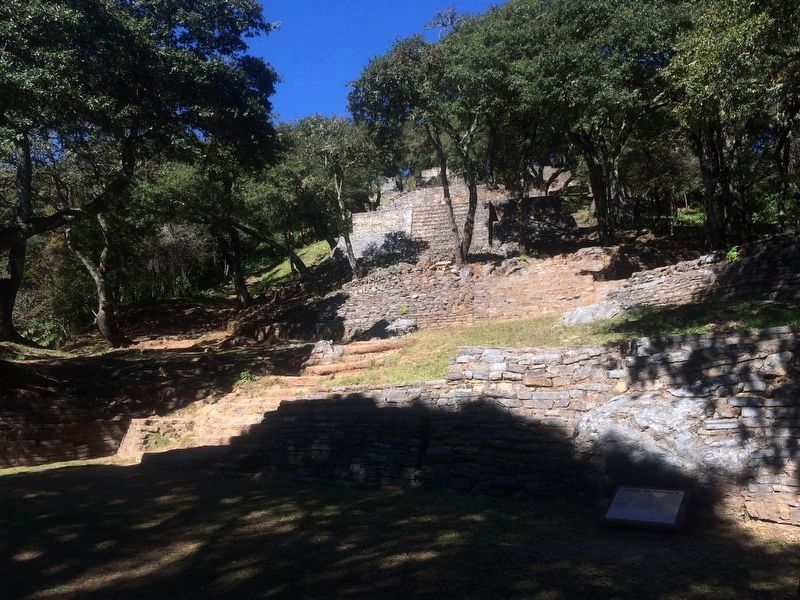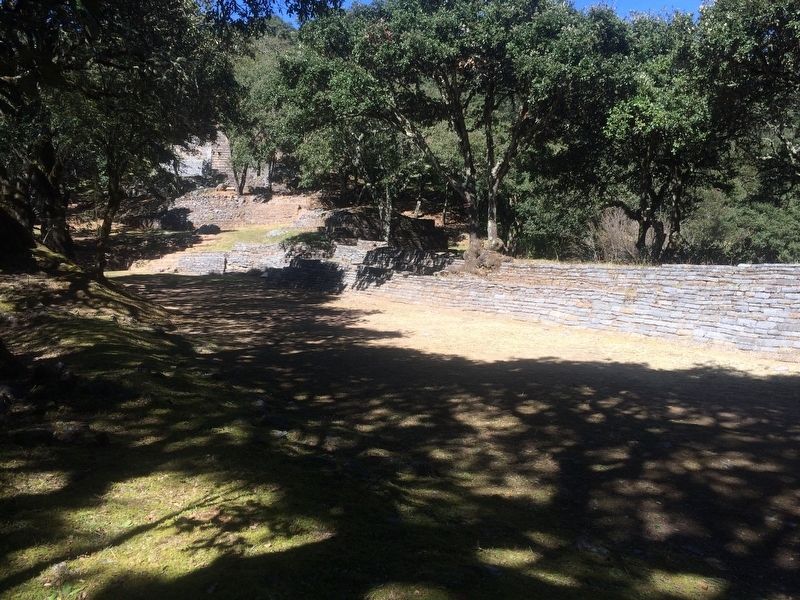San Joaquín, Querétaro, Mexico — The Central Highlands (North America)
Ball Court Three
Juego de Pelota 3
Este juego de pelota aprovecha la unión de dos cerros o puertos. Para su construcción se edificaron dos grandes muros de contención. Actualmente, está restaurado el paramento norte que es el mejor conservado. Al este existió un basamento que remataba uno de los lados de la cancha, pero fue desmantelado hasta sus cimientos por los primeros habitantes del actual San Joaquín para construir sus casas. El mismo destino sufrió gran parte del paramento sur y ahora sólo quedan restos aislados de esta construcción. Este juego de pelota es importante porque da continuidad a dos secciones de la ciudad. Sobre una gran nivelación, donde culmina el paramento norte, se ubica la Estructura 1 de Ranas II. Durante la exploración de esta estructura en 1984-1985, se detectó en su interior el entierro de 11 individuos, lo que se interpretó como una ofrenda de mano de obra a sus dioses.
Juego de Pelota 3
Núna teenga nuúni fatsi núa di nthe yóho ya toho gea di ngo sthi. Bi za bri lútsuabi yoho ya dáaánga nótsa jado. Ja yothoki ra njoi ya İado nge mahuifi gea hintsa xa meétsi ya ñóte. Ri nge mahyatsi bi njaáni na ra húdigea mi jatsi na di geu ya hyo ra bátha nteeni, nsokthoho núu ya múdi nangu ra hninibye San Joaquín bi xémi bi gumpabi hà rá ntúta jado njani bi za bi hyoe yá nguú. Bi njaáni neéhe doóngi rí njaáni nge makangi ha nubye kóhi seéhe ra ya ránga mbóngi di gehna thongu. Núna nteénga nuúni xi ja rá múui ngetho gehna pechni yóho ya ntéke ra thongu hniini. Maxotse há na ra daánga batha, hábu ri gatsi ra doóngi rí njaáni mahuifi, ja ri nidini rá Ntui na (1) ra Tiue yóho (2). Ya jeya 1984-1985 núbu mi nja ra nthóni bi tsudi rá ntági núu réta ma ra ya jai há mbo núna thongu, gea bi mha gea na rá boñha rá tote rá yeu ya zi daáda.
Ball Court Three
This ball court takes advantage of the union of two elevated hills, or mountain passes. Two large retaining walls were built in preparation for its construction. The best conserved, the north wall is restored. To the east existed a base found at the end of one of the sides of the court, but was dismantled to its foundations by the first inhabitants of the present-day village of San Joaquín for the building of their houses. A large part of the south wall suffered the same destiny and now only isolated remains of this structure exist. This ball court is important because it gives continuity to two sections of the city. Structure 1 of Ranas II is located
on the top of a great platform, where the north wall ends. During its exploration in 1984-1985, remains of a burial of 11 individuals were found in the interior of this structure, which can be interpreted as an offering of manpower to the gods.
Erected by Instituto Nacional de Antropología e Historia (INAH).
Topics. This historical marker is listed in these topic lists: Anthropology & Archaeology • Architecture • Native Americans • Sports.
Location. 20° 55.557′ N, 99° 33.871′ W. Marker is in San Joaquín, Querétaro. Marker is on Unnamed Road. The marker is at Ranas Archaeological Site to the north of the town of San Joaquín, on an unnamed but well-known road, near the "Finca de Doña Lore". Touch for map. Marker is in this post office area: San Joaquín QUE 76550, Mexico. Touch for directions.
Other nearby markers. At least 8 other markers are within walking distance of this marker. Building Three (a few steps from this marker); Archaeological Work (within shouting distance of this marker); The Doors of the City (about 90 meters away, measured in a direct line); The Sunken Patio Complex (about 90 meters away); The Buildings 16 and 16-b (about 120 meters away); The City and its Territory/The Inhabitants (about 120 meters away); Las Ranas and the Access Complex
(about 120 meters away); Ball Court Two (about 120 meters away). Touch for a list and map of all markers in San Joaquín.
Credits. This page was last revised on January 23, 2018. It was originally submitted on January 21, 2018, by J. Makali Bruton of Accra, Ghana. This page has been viewed 116 times since then and 7 times this year. Photos: 1, 2, 3, 4. submitted on January 21, 2018, by J. Makali Bruton of Accra, Ghana.



